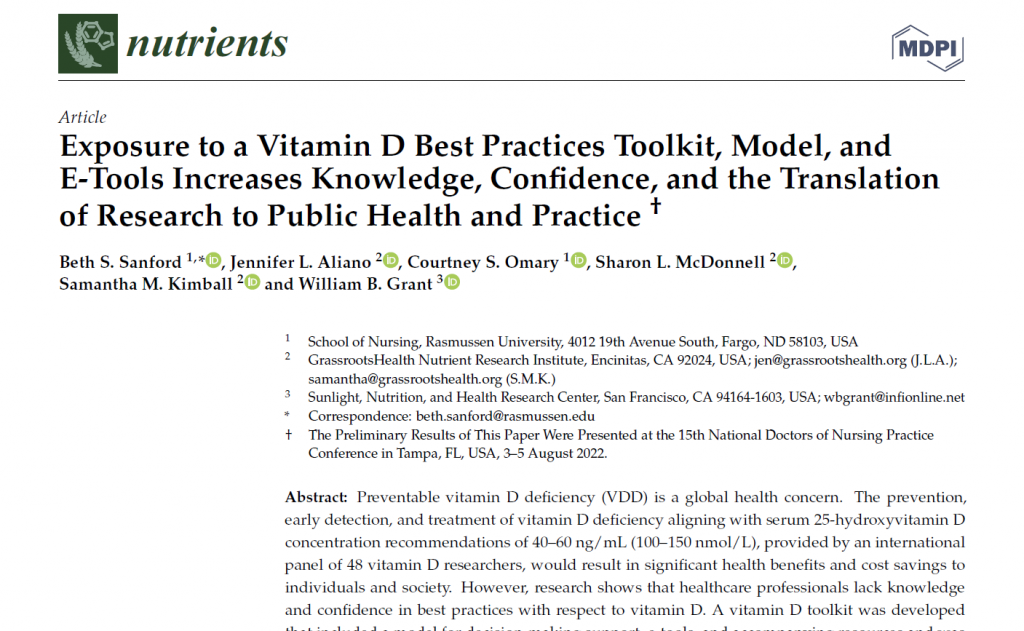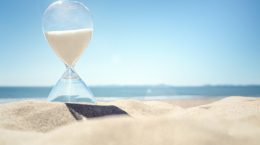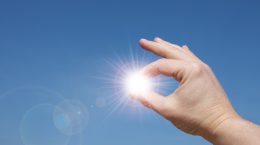Published on May 29, 2023
This quick quiz can help you determine if your daily habits are more or less likely to be supporting and maintaining healthy vitamin D levels
Key Points
- To help educate individuals about their unique risk factors for vitamin D deficiency and to highlight when testing may be of extra importance, GrassrootsHealth created The Vitamin D Deficiency Risk Assessment Quiz (Beta), a short set of questions about an individual’s supplemental vitamin D intake, UVB exposure, and low exposure indicators to assess risk level of having a low, moderate, or high risk of having a vitamin D level below the scientists’ recommended minimum of 40 ng/ml (100 nmol/L)
- Based on all the factors considered, the role of midday sunshine and UVB exposure proved to have a large influence on an individual’s vitamin D level, demonstrating the importance of exposure to UVB for vitamin D status, and highlighting the need for vitamin D supplementation when one does not meet their daily UVB requirements
- Receive the full benefits of vitamin D and sunshine by getting to know your vitamin D level first, followed by learning how to create a healthy supplement and sunshine or UVB exposure routine based on your unique individual factors
GrassrootsHealth, with Dr. Beth Sanford and Dr. William Grant, has just published a paper on utilizing a best practices model and toolkit for improving vitamin D knowledge and confidence among individuals and health care providers! The goal with this paper was to show the success of our online vitamin D education course (CEUs available for nurses and dietitians) and supporting resources in filling existing gaps that currently prevent the translation of vitamin D research into practice.
Learn More About the eCourse Here
A Key Educational Component: The Vitamin D Deficiency Risk Assessment Quiz
To help educate individuals about their unique risk factors for vitamin D deficiency and to highlight when testing may be of extra importance, GrassrootsHealth created The Vitamin D Deficiency Risk Assessment Quiz (Beta), a short set of questions about an individual’s supplemental vitamin D intake, UVB exposure, and low exposure indicators to assess risk level. Scoring is intended to determine if an individual has a low, moderate, or high risk of having a vitamin D level below the scientists’ recommended minimum of 40 ng/ml (100 nmol/L).
The questions include the following:
1. What is your age in years?
2. Where do you live? (country, state/province, city)
3. What is your height?
4. What is your weight?
5. Which of the following statements apply to you? (choose all that apply)
a. I have dark skin color (dark brown or black)
b. I cover more than 90% of my body when outdoors
c. I regularly work night shift
d. I have hobbies that keep me indoors throughout the day on a regular basis (e.g. TV, video games or computer use)
e. None of the above
6. Which of the following statements apply to you? (choose all that apply)
a. I regularly use a UVB tanning bed (at least 2 or more times per week)
b. I spend the majority of midday from 10am to 2pm outside in the sun (as least 3-4 or more times per week)
c. None of the above
7. Do you take a supplement with vitamin D? (yes/no)
a. If yes, how much vitamin D do you take? (IU or mcg)
b. If yes, how often do you take it?
i. every day
ii. most days
iii. weekly
iv. monthly
These questions are then followed up with a list of conditions and medications that can either affect vitamin D levels or increase the risk of deficiency; some of the conditions may also indicate a situation in which a higher target vitamin D level may be desired. Answering this section does not affect the score of the quiz, however, each item listed indicates a situation in which special attention to vitamin D may be necessary.
Completing this quiz creates an opportunity to educate yourself or someone else on the factors that have the greatest influence vitamin D levels. Check it out today!
Supplements, Sunshine & UVB Exposure are the Key Factors in Determining Risk of Vitamin D Deficiency
![]() When creating the quiz, data from the GrassrootsHealth cohort and several other publications was analyzed to see which factors had the most influence on vitamin D levels. Variables considered included vitamin D supplement intake, sunshine exposure habits (including amount of time spent outside, clothing, sunscreen use, skin type), indoor tanning, diet, latitude, gender, age, weight, health conditions, and current medications.
When creating the quiz, data from the GrassrootsHealth cohort and several other publications was analyzed to see which factors had the most influence on vitamin D levels. Variables considered included vitamin D supplement intake, sunshine exposure habits (including amount of time spent outside, clothing, sunscreen use, skin type), indoor tanning, diet, latitude, gender, age, weight, health conditions, and current medications.
The most important factors found to affect vitamin D levels and the risk of having a low vitamin D level were
- average daily supplemental dose of vitamin D by weight
- use of indoor UVB tanning beds
- time outdoors in the midday sun, and
- factors that would affect the amount of vitamin D produced from sunshine exposure, such as skin color and clothing
Data from the GrassrootsHealth prospective cohort study was used to determine the average supplemental vitamin D amount per pound to achieve 40 ng/ml (100 nmol/L; N=7,324). Responders who indicate taking at least this amount are scored at low risk for having a low vitamin D level.
Additionally, more than 50% of non-dark skinned, non-supplementing GrassrootsHealth participants who regularly use a UVB tanning bed have a vitamin D level at or above 40 ng/ml (N=1,650). Therefore, non-dark skinned responders who indicate regularly using a UVB tanning bed or spending extended time in the midday sun are scored low risk.
Responders who take less than the average supplemental amount to achieve 40 ng/ml and do not have regular UVB exposure (or are dark skinned) are then scored moderate or high risk based on their low UVB exposure indicators. Data from GrassrootsHealth participants with these characteristics who have reported on their low exposure indicators (dark skin, covering their body 90%+ when outdoors, working night shift, or having regular indoor hobbies) have shown that those reporting at least one of those habits have 2.2 times the risk (p<0.001) of having a vitamin D level below 40 ng/ml than those who do not report any. Therefore, these responders are scored moderate risk if they do not report any low exposure indicators and high risk if they report at least one.
Based on all the factors considered, the role of midday sunshine and UVB exposure proved to have a large influence on an individual’s vitamin D level, demonstrating the importance of exposure to UVB for vitamin D status, and highlighting the need for vitamin D supplementation when one does not meet their daily UVB requirements. Understanding the risks and benefits of exposure to midday sunshine, and learning how to incorporate healthy sunshine exposure into a regular routine according to your skin type, can help everyone avoid vitamin D deficiency while also receiving the additional benefits that result from healthy sunshine exposure.
To reap the full benefits of vitamin D and sunshine, getting to know your vitamin D level is the first step, followed by learning how to create a healthy supplement and sunshine or UVB exposure routine based on your unique individual factors. Taking the quiz can help you identify areas that may be affecting your risk of vitamin D deficiency, and how your daily habits can be addressed in order to minimize risk.
Vitamin D Status is Essential to Consider with Supplementation
One important detail to keep in mind when considering the score from your quiz is that the vitamin D blood level can be a more important measurement to consider than vitamin D supplement intake. This is due to the variability in dose-response (or how someone responds to any given dose); when supplementing with vitamin D it is impossible to know how much of a dose might be “right” for one person to the next without measuring their resulting nutrient status. For example, it is possible for a supplemental intake of 4000 IU/day to result in a serum level of 25 ng/ml (62.5 nmol/L) in one individual, and 60 ng/ml (150 nmol/L) in another. A GrassrootsHealth analysis showed that among all adult participants taking an average of 4,000 IU vitamin D per day from supplements, approximately 25% were still below the recommended 40-60 ng/ml.
Make Sure You Are Getting Enough of Both Sunshine & Vitamin D
It is important to incorporate safe, sensible sun exposure into a regular routine, just as it is important to make sure you are getting enough vitamin D. Because the sun produces many health-benefiting molecules in addition to vitamin D, sunshine exposure cannot be replaced with taking a supplement.
It is also important not to stop supplementing with vitamin D during the summer. Most people do not make enough vitamin D from sunshine alone, due to their lifestyle and other factors, and therefore must rely on supplementation to maintain optimal vitamin D levels of 40-60 ng/ml (100-150 nmol/L).
This Sunshine Month, get 10% off your home blood spot test kits PLUS the free Sunshine eBook when using the code SUNMONTH24 at checkout.
Measure Your Vitamin D Level Today
 Having and maintaining healthy vitamin D levels and other nutrient levels can help improve your health now and for your future. Choose which additional nutrients to measure, such as your omega-3s and essential minerals including magnesium and zinc, by creating your custom home test kit today. Take steps to improve the status of each of these measurements to benefit your overall health. With measurement you can then determine how much is needed and steps to achieve your goals. You can also track your own intakes, symptoms and results to see what works best for YOU.
Having and maintaining healthy vitamin D levels and other nutrient levels can help improve your health now and for your future. Choose which additional nutrients to measure, such as your omega-3s and essential minerals including magnesium and zinc, by creating your custom home test kit today. Take steps to improve the status of each of these measurements to benefit your overall health. With measurement you can then determine how much is needed and steps to achieve your goals. You can also track your own intakes, symptoms and results to see what works best for YOU.
Enroll in D*action and Test Your Levels Today!






